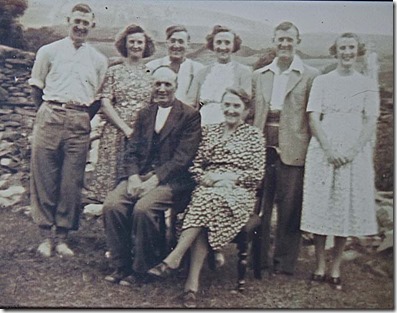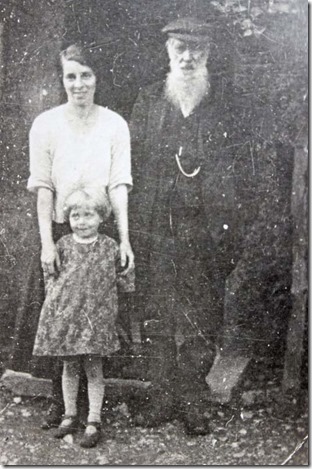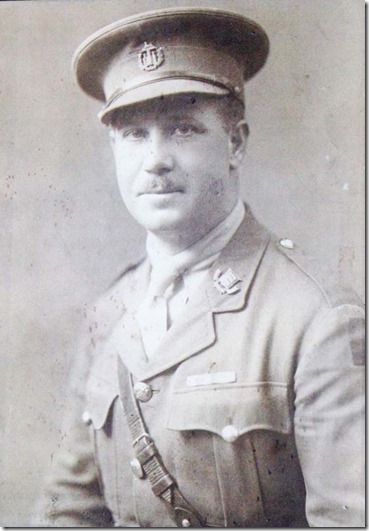Pte William Thomas ‘Tot’ Dinsdale; Pte Thomas Spence; Major Donald Herbert Rose MC and Sgt Ernest Moore; Col John William Lodge; and Pte John Percival. Plus Aysgarth Parish and WWI
Pte William Thomas ‘Tot’ Dinsdale
‘Granddad was never the same man again. He was gassed [mustard gas] towards the end of the war. When the Armistice came he was in a hospital somewhere in the Midlands. He was there for a long time. He just got out before the hospital was decimated by Spanish Flue,’ said John Dinsdale of Hawthorn Farm, Thornton Rust. (John is the chairman of Aysgarth and District Parish Council). He continued:
‘Granddad went back to farming at Sedbusk but he was never a fit man. He was always short of breath. If he did anything strenuous he was jiggered. When the lads [his sons] got to be 12 or 13 they did most of the work.
Above: Tot and Charlotte Anne Dinsdale with their children l-r Thomas (John’s father and also known as ‘Tot’), Alice, Jim, Dorothy, Jack and Margaret.
Below: The kettle presented to Tot Dinsdale by High Abbotside Parish Council in recognition of his service during WW1
Pte Dinsdale fought with the 1/4th Battalion Yorkshire Regiment throughout most of the war apart from when he was recovering from being wounded, John said.
‘He joined up at Hawes when they first started recruiting – I think there were 15 or 16 of them from the Upper Dale and then they all marched to Leyburn with the rest from the Dale. He thought it was the right thing to do. He was 19 or 20.’
The 4th Yorkshires first experience of trench warfare was during the Battle of Ypres from April to June 1915. The front line battles the battalion was involved with included Armentieres from August to December 1915, the Somme from August to November 1916, Ypres October 1917 (Tot returned to the battalion in time for Passchendaele) to February 1918, and Aisne in May 1918.
At Aisne on May 27 1918 the battalion and others fighting alongside it was decimated by a massive German attack. That was the end of the 4th Yorkshires as a fighting unit during WW1. (from 4thYorkshires.com).
Like many others who returned home after the war Tot found it difficult to talk to anyone about it other than those who had also fought in the trenches. The two he turned to were Anthony and Jack Fawcett, his brothers-in-law, from High Abbotside.
John said: ‘They would go into the far room and shut the door. I’m pretty certain they were talking about the war but as soon as anyone went in they shu7t up. They never talked to us about it. But granddad did talk to my Uncle Ernie – his son-in-law.’ (Ernest Metcalfe)
Anthony ‘Ant’ Fawcett was given a small book of Common Prayer and Hymns Ancient and Modern by his sister Annie (later Mrs Pratt) in February 1914 and he carried that with him throughout the war. From the state of the pages it is obvious that he read some of the hymns a lot such as No230. (See Penny Barker’s address in Remembrance Service at Aysgarth Church)
Family photo courtesy John Dinsdale. Other photos by Pip Pointon.
Pte Thomas Spence
Pte Thomas Spence of Walden and West Burton was one of those who did come home from WW1 but then died during the flu epidemic. ‘He was gassed and later got the flu. He died at home,’ said his grand-daughter, Frances Sledge of Leyburn.
For his wife, Fanny, and daughter, Grace Kathleen, his death meant that they had to leave their home in West Burton. Fanny took her daughter back to her family in Wharfedale. They either lived with Fanny’s parents (William and Deborah Gill) at the post office in Buckden or they stayed with her aunt and uncle at Fold House Farm in Kettlewell.
It was to those addresses that his medals (the British War Medal, the Victory Medal and the 1914-1915 Star) were sent and the family carefully stored them in the boxes and envelopes in which they came.
Tom was born at Hargill Haw Farm in Walden where his father, John farmed. He had four siblings: Margaret, Grace, Sarah and John. In the 1911 census he was described as a 15-years-old draper’s apprentice. By 1915 he had enlisted with the 4th Battalion Yorkshire Regiment (Green Howards).
On April 1 1915 he wrote to his mother, Margaret Spence, from Newcastle-on-Tyne: “Dear Ma, I arrived safe and sound, but I got a very pleasant surprise, we are of (sic) across before the 18th of this month. Dont fret or worry I shall be alright…. Tell uncle Kit I am of but dont forget I shall come safely back again. I had a very enjoyable time at Northallerton…. Tell Mr Roulden I shall write to him soon now, to let the School children know how we get on. … I am in the Pink of health. I am your loving son Tom. Remembrance to all at Burton.”
His battalion had moved from its home base at Northallerton and, just as Tom said, was sent to France on April 18, and straight into battle in the Ypres sector. The regiment saw action at the Battle of the Somme in 1916 which was probably when he was gassed. He received his honourable discharge certificate and silver badge after being in hospital in August 1916.
He married Fanny Gill at Skipton registry office in August 1918 but died on April 18 1819 aged 23. He was buried in Aysgarth churchyard four months before his daughter was born. In the 1911 census her grandmother, Deborah, then 57-years-old, was described as being in charge of the post office at Buckden. Deborah’s husband was then 71-years-old.
“He was a shoemaker. He had a long beard and lived until he was in his nineties,” said Mrs Sledge. Below: William Gill with his daughter, Fanny Spence, and grand daughter.
Major Donald Herbert Rose MC and Sgt Ernest Moore
The Festival of Remembrance at St Andrew’s Church, Aysgarth, in November 2018 provided an opportunity for Hugh Rose of Leyburn and Catrina Cloughton of Thornton Rust to remember their father: Major Donald Herbert Rose MC (above).
Major Rose was born in 1885 in Lincolnshire, went to what was then Ceylon in 1910 and became a tea and rubber planter. He joined the Ceylon Planters Rifle Corps (CPRC) in 1911. Lance Corporal (Rifleman) Rose was among the 237 from the Corps who were sent to Egypt in October 1914. They initially helped to defend the Suez Canal against Ottoman Turkish attack.
In December that year they joined the Wellington Battalion of the newly formed Australian and New Zealand Army Corps (Anzac). They made such a good impression that many were sent for officer training. Rose did his in Egypt with the 1/6 Essex Regiment. In August 1915 the regiment was sent to Suvla Bay, Gallipoli. Those who survived were evacuated in December 1915, first to guard the Suez Canal and then to fight the Turkish Army through Egypt into Gaza.
Major Rose commanded the company which was the first to enter Gaza City. From there they went to Damascus where he and his company marched into the city 200 yards behind General Allenby and Lawrence of Arabia. He finished in Baghdad and returned to Ceylon in 1919.
He remained there until the early 1950s by which time he was married. On returning to England they finally settled in Thornton Rust when his wife Joan became the assistant matron at what was then a sanatorium at Thornton Lodge. He died in 1963.
“Trina” Cloughton also shared the sad love story of her maternal great uncle Sgt Ernest Moore.
He grew up in Tudhoe Colliery in Co Durham, the only son of John and Alice Moore. John was from a mining family but attended evening classes after he left school when he was 14. He worked his way up to becoming a mine’s inspector. His job included making sure there was no gas in the mines said Trina.
When Ernest joined the Durham Pals (18th Battalion Durham Light Infantry) at Craken Hall on 29 December 1914 he was 20 years and 10 months old and listed his occupation as “shop assistant”.
After training the Durham Pals were sent to Egypt late in 1915 to defend the Suez Canal. They were then moved to France in March 1916 for the “Big Push”. Sgt Moore survived the Battle of the Somme but was killed in action on 19 May 1918. He was buried at Caestre Military Cemetery in France.
He had hoped to return and marry his girlfriend and had given her a bracelet as an “engagement” present before he went overseas.
Mrs Cloughton said: “He was ‘engaged’ to one of my grandma’s sisters, Emma Musgrave. He and Aunty Emma loved poetry. He sent her a book of poems each Christmas. They are suede covered and wouldn’t have been cheap.”
Emma cut out the “In Memoriam” notice in the local newspaper and stuck it on a page in one of those books. The notice read: “Roll of Honour. MOORE. – In cherished memory of Sgt. E. Moore (Durham Pals), beloved son of Mr. and Mrs. J. G. Moore, Tudhoe Colliery, who fell in France May 19th, 1918. Safe in our Father’s home until the day breaks and the shadows flee away.”
And the poem on that page was God’s Acre:
I like that ancient Saxon phrase, which calls
The burial-ground God’s Acre….
God’s-Acre! Yes, that blessed name imparts
Comfort to those who in the grave have sown
The seed that they had garnered in their hearts,
Their bread of life, alas! no more their own….
Below: It is likely that Sgt Moore is the man with a cigarette standing at the back with his arm resting on a friend’s back. He does look older and battle weary compared to that above which was probably taken before he left England for the Western Front.
Aysgarth Parish and WWI
In December 1918 the vicar of Aysgarth, the Rev William K Wyley wrote in the parish letter: “I wonder if, in the years to come, November 11 will overshadow the 5th as a day greatly to be remembered.”
He was, however, very aware that dalesfolk were in the midst of the great Spanish Flu epidemic and that the WW1 peace agreement had not yet been signed.
Two soldiers, L/Cpl John Wood of Carperby and Driver William Metcalfe of Aysgarth, were given compassionate leave when their wives became ill with the flu. Both women died, Eleanor Metcalfe (22) before her husband got home.
Soldiers began to be demobbed in early 1919 and this led to Mr Wyley publishing an interesting ‘advert’ in the parish magazine: “The Employment Exchange at Northallerton has asked me to state that it has on its Registers women discharged from War Service and suitable for several classes of employment.”
It was acknowledged that women had an important part to play in reconstruction. The role that women had played during the Great War was recognised when limited suffrage was granted to them in 1918.
In October 1918 Mr Wyley commented: “We are approaching the time when, as a nation, we shall realize more fully what a tremendous change the war has made in the social, industrial and religious life of England.”
In that letter he reminded everyone about the great need of economy in the use of oil and especially coal. “I know that very many of us are reducing our fires to a very low minimum, and where wood fuel is available I am sure we shall be careful to ‘do our bit’ in this respect for our country.” He had regularly emphasised the need for food economy and, in June 1917, explained why (below).
WW1 had a massive impact upon the lives of everyone and not just because of the ravenous war machine in France and Belgium. The parish magazines not only listed those who had enlisted – but also those who were killed.
When war first broke out local people didn’t know how to respond. Initially events were cancelled but it didn’t take long for people to realise that they could use the church’s flower festivals and other celebrations to raise money for the War Working Parties or to be sent direct to hospitals caring for the war wounded. Concerts, jumble sales and tea parties were also held.
In May 1915 there was a bold headline: “200,000 Eggs wanted weekly for the wounded.” The National Egg Collection had been launched with the request that each household should send one each week to help the recovery of wounded soldiers. The West Burton and District Scout Troop took on the job in the parish and by late November had collected 6,144 eggs. These were sent to military hospitals in France and Malta and some to wounded soldiers at Leeds Infirmary.
 Right: published in the Aysgarth section of The Upper Dales Parish Magazine in December 1917
Right: published in the Aysgarth section of The Upper Dales Parish Magazine in December 1917
Children helped with collecting sphagnum moss for dressing wounds, made items of clothing and, in November 1917, were encouraged to collect horse chestnuts for munitions and also waste paper. Mr Wyley reported that within two months he received half hundredweight of horse chestnuts and four hundredweight of waste paper.
The times of services had to be adjusted when lighting restrictions were introduced in February 1916 following air raids by Zeppelins. And the shortage of manpower was beginning to have an effect. In July 1918 Mr Wyley wrote: “May haytime be favourable and health and strength sufficient to tide over the shortage of labour.”
Conscription was introduced in January 1916 and in July 1917 he wrote: “I am glad to say that the local Tribunal has granted exemption to our Sexton on condition that he is released as far as possible for agricultural and other work of National importance.
The signing of the Peace Treaty in July 1919 led to celebrations throughout the country and the Empire. But in Wensleydale the hay harvest had to come first. Mr Wyley commented: “I hope that when all the hay has been led each village… will do something to mark our rejoicing over the Peace and our gratitude to the men who won the possibility of it.”
This has been edited from the Aysgarth sections of the Upper Wensleydale Parish Magazines 1914-1918. Aysgarth parish consists of Aysgarth, Carperby, Bishopdale, Thoralby, Thornton Rust and West Burton.
Below: The peace celebrations in 1919 at The Rookery in Bishopdale (courtesy DCM) The Rookery no longer exists.
For more stories see the WWI section of the Thoralby Through Time website.
Col John William Lodge
 The biggest military funeral at Aysgarth church during WW1 was that for Col John William Lodge with the band of his regiment and the detachments of two battalions being present. The firing party fired volleys over his grave and buglers sounded the Last Post. He was 60-years-old when, on leave at his home at The Rookery in Bishopdale, he died on 23 August 1917, after a short illness.
The biggest military funeral at Aysgarth church during WW1 was that for Col John William Lodge with the band of his regiment and the detachments of two battalions being present. The firing party fired volleys over his grave and buglers sounded the Last Post. He was 60-years-old when, on leave at his home at The Rookery in Bishopdale, he died on 23 August 1917, after a short illness.
He had served in the Boer War and from 1906-1912 had commanded the 3rd Battalion of the Yorkshire Regiment. At the outbreak of the 1st World War he had immediately returned to the battalion as a major and in May 1916 was appointed to the command of a Garrison Battalion. (Information and photo courtesy Wensleydale Remembered)
Pte John Percival
There wasn’t a military funeral for Pte John Percival but there is a military gravestone. He was 21-years-old when he died and was buried on 12 April 1918.
This obituary was published about him:
“He enlisted when he was 19, and after being trained at Rugeley Camp, went to France in April 1916, and was through the battle of the Somme, being badly wounded in the hand in September 1916. He was sent back to England for treatment, and made a sufficient recovery to enable him to return to service.
“As he was a competent motor driver he was transferred by the authorities from the Yorkshire Regiment to the Motor Transport, Army Service Corps, in June 1917. In this work he did good service until October last, when he was badly gassed, and was seriously ill. He returned to England, and was in the 1st London General Hospital, Camberwell, until November 27th, when he was officially discharged from the Army as physically unfit for further service.
“A relative went to London to bring him home. He was very weak, and while crossing London an air raid was proceeding, and the journey was several times interrupted. Arrived at Aysgarth he was very happy to see his home and family, and seemed to revive for a while, but the gas had seriously damaged his lungs and recovery was seen to be impossible.
“Though relatives and friends nursed him tenderly day and night there was no progress towards health. The funeral was largely attended by sympathising friends, and some beautiful wreaths and affectionate messages were sent.”










